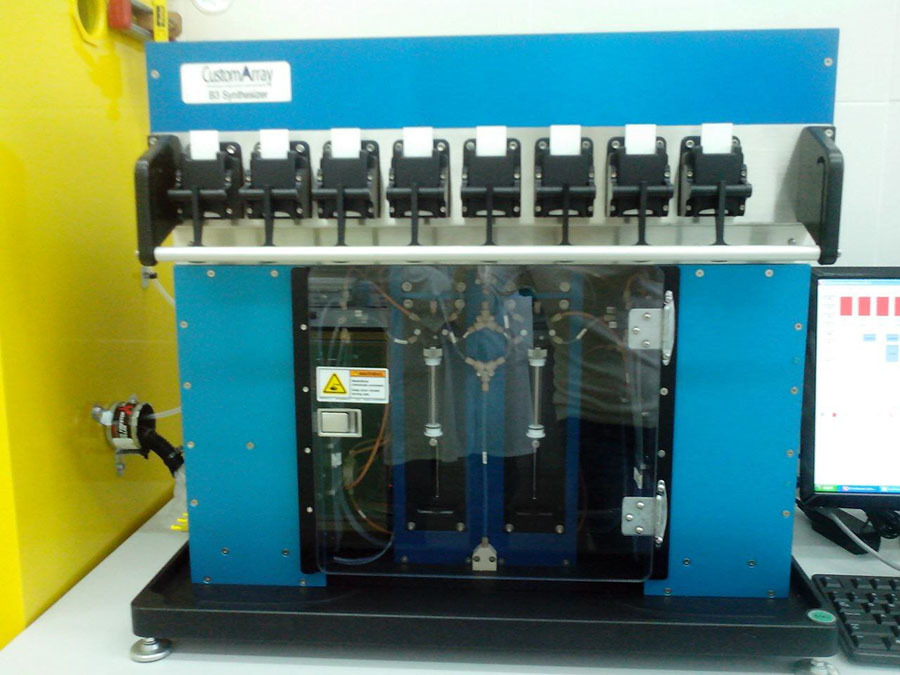Since January 2020, FBSI "Nizhny Novgorod Institute of Epidemiology and Microbiology named after
Academician IN Blokhina "Rospotrebnadzor began active work on laboratory diagnostics of new coronavirus infection.
As Rospotrebnadzor said in mid-July, among the numerous studies and developments related to the new virus, scientists' efforts are aimed at creating a biochip for the indication of topical pathogens of community-acquired pneumonia, including the SARS-CoV-2 virus.
- Oleg Vladimirovich, please tell us what the chip is and how it detects strains of coronavirus?
DNA biochip
© Oleg Utkin
- A chip is a plate with a silicon substrate 25x75 mm in size and a working area - a set of platinum nanoelectrodes.
A USB port, like a USB flash drive, connects the chip to a computer.
When a sample of biomaterial is applied to the working area, a reaction occurs.
Information about this reaction, its intensity, parameters is sent to the computer.
Further, the program helps the researcher determine whether the studied biomaterial contains a specific virus and its strain.
- How is this method fundamentally different from conventional PCR test systems?
- The usual PCR test answers only one question: is there any pathogen in the sample or not.
If there is no information about the specific microorganism that caused the disease, several diagnostic tests should be performed to confirm the doctor's assumption.
In this case, a situation may occur when not all the alleged causative agents of the disease can be taken into account, and then there is an option of "incomplete" laboratory diagnosis of the disease.
The chip we are developing is, in fact, a universal test that allows one to identify at once many of the currently existing variants of pathogens.
- Is this chip your invention?
- In general, this technology has existed for a long time - it was developed by one of the American companies. It is a chip printer and related software. One chip can be used several times with the issuance of certain parameters, according to the task at hand. But to establish their compliance with specific features of the sample is just the subject of research that we have planned in our work.
We plan to use the chip to be created to identify the actual causative agents of community-acquired pneumonia, including the SARS-CoV-2 virus.
In addition, we are developing our own sample preparation algorithm.
It should be understood that not saliva itself or another biomaterial is applied to a test tube in a conventional PCR test, but not saliva itself or another biomaterial, but nucleic acid isolated from it, prepared in a certain way.
In the variant with the chip, imported, rather expensive reagents are used.
Our sample preparation option is expected to be about 2.5 times cheaper.
Moreover, we have determined the necessary parameters of the chip that are optimal for the tasks at hand.
- Can the whole world use the parameters you received, all other owners of printers with chips, or is it know-how?
- Scientists share this data freely.
Our colleagues will try, recheck, confirm themselves.
But the technology of biomaterial sample preparation, most likely, will belong to the category of results of intellectual activity.
- Is it possible to carry out tests using chips in the near future?
- In theory, yes.
It is assumed that the printers can be installed in individual large medical institutions, and ready-made chips can be brought to the laboratory in the field, which can be used several times.
So far, the cost of classic PCR tests is much lower.
But technologies are developing and do not stand still.
We expect and hope that this analysis will be available for the foreseeable future.
DNA biochip printer
© Oleg Utkin
- That is, the story is like with tomographs. First, a unique device in one federal center, and after a few years in all district polyclinics?
- Yes, the analogy is quite appropriate, since technologies become cheaper over time.
In particular, our sample preparation in the future will significantly reduce the cost for more widespread use.
Previously, chips were used exclusively for scientific research.
Although, in principle, they can be used for other genetic analyzes carried out today in routine research in both medical and scientific institutions of the country.

